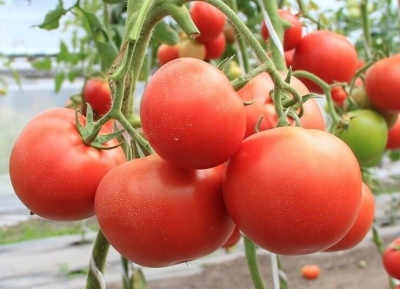
- Authors: Gavrish S.F., Morev V.V., Amcheslavskaya E.V., Volok O.A. (Scientific Research Institute of Vegetable Plant Breeding, LLC Gavrish Breeding Firm)
- Year of approval: 2002
- Name synonyms: Eupator F1
- Category: hybrid
- Growth type: indeterminate
- Appointment: fresh consumption, for pickling and preserving
- Ripening period: mid-early
- Ripening time, days: 107-110
- Growing conditions: for open ground, for film greenhouses, for greenhouses
- Marketability: high
Despite the fact that the time when it was impossible to survive without a vegetable garden has passed, many continue to grow vegetables near their homes. Summer residents are trying to get a huge harvest without compromising the quality of the fruit and with the lowest physical and material costs. A good option for cultivation is the Eupator tomato. We will consider its features in the article.
Breeding history
Wishing to facilitate the work of gardeners and gardeners, specialists Gavrish S.F., Morev V.V., Amcheslavskaya E.V., Volok O.A. have experimented with tomato varieties for years to develop the perfect plant. Finally, in 2002, the world saw one of the best hybrid varieties - Eupator.
Description of the variety
Tomato Eupator F1 is characterized by an indeterminate type of growth. The authors of the variety note that the bushes of the variety are powerful and reach 2-3 meters in height. This makes Eupator an ideal candidate for outdoor and greenhouse cultivation.
The fruits of this variety are suitable for fresh consumption and canning. Eupator is distinguished by high marketability and transportability, the yield of marketable fruits is 99%, and they can be stored for up to 10-14 days, thanks to which the variety quickly gained popularity among those who are engaged in industrial production.
The main qualities of the fruit
The inflorescence of the hybrid is simple, the first is laid above 9 leaves, the subsequent ones - after 3 leaves. Unripe fruits of the Eupator tomato are light green in color; as they ripen, they evenly turn red. At the exit, 6-8 flat-round tomatoes are obtained in a brush, each of which weighs an average of 109-126 grams.
Taste characteristics
The main thing in the fruits of tomatoes is their taste, because it is for this that people spend time and effort growing vegetables. The sweet-sour flesh of a rich red color distinguishes the Eupator tomatoes. The fruits of this variety will charm both adults and children, because they have a dense, but not rough skin.
Ripening and fruiting
The Eupator variety is medium early, and the ripening period is 107-110 days. Some gardeners consider it early, because with proper care and under optimal conditions, fruits can be obtained in 85-90 days.
Yield
With minimal care, you can get up to 5.5 kg of tomatoes from each bush. According to official data, the yield is 38.4 kg / sq. m, which allows us to characterize the variety as high-yielding.
The timing of planting seedlings and planting in the ground
Sowing for seedlings is carried out in mid or late March, and planting of seedlings in the ground - in early to mid May, depending on the growing region and weather conditions. The average age of plants at which they should be moved to a greenhouse or outdoors is 45 days.

Growing tomato seedlings is an extremely important process, because it largely depends on whether the gardener will be able to harvest at all. All aspects must be taken into account, from seedbed preparation to planting in the ground.
Landing scheme
Seedlings are planted according to the 40x60 cm scheme to provide the root system of each bush with the opportunity to develop. Despite the fact that the branching of the bushes is average, they need more space than other varieties.

Growing and care
The Eupator variety does not require special care. To obtain an ideal harvest, it is enough to plant, plant, and form bushes on time.
Important: when forming a tomato, it must be borne in mind that it is carried out in 1 stem. Tomatoes of the variety in question also require regular pinching. It is held in the early morning hours. In addition, you must remember to tie up the culture so that it does not break under the weight of the fruit.
Another nuance that you need to pay attention to will be the timely introduction of fertilizing twice a season: before flowering and before harvesting. The plant is watered once a week, 1/4 of a bucket under each bush; in dry weather, watering is carried out more often.




A plant needs different micronutrients at each stage of growth. All fertilizers can be divided into two groups: mineral and organic. Folk remedies are often used: iodine, yeast, bird droppings, eggshells.
It is important to observe the rate and period of feeding. This also applies to folk remedies and organic fertilizers.
Disease and pest resistance
Most of the problems with growing tomatoes arise from low disease resistance. Eupator is the same variety that is resistant to a number of diseases. He resists well
- late blight;
- top rot;
- cladosporium disease;
- the tobacco mosaic virus.
The tomato is also resistant to fruit cracking and fusarium wilt.


Growing regions
This variety is popular with gardeners in different regions, and the reason for this is its resistance to adverse weather conditions. It is suitable for growing in the North, North-West, Central, Volgo-Vyatka, Central Black Earth Region, North Caucasian, Middle Volga, Nizhnevolzhsky, Ural, West Siberian, East Siberian and Far Eastern regions.
Review overview
Gardeners who have tried to grow this variety at least once will definitely plant it next year and will recommend the tomato to their friends. The number of positive qualities of the Eupator tomato prevails over its disadvantages. The main disadvantage, judging by the reviews, was that it does not have 100% germination.

























































































